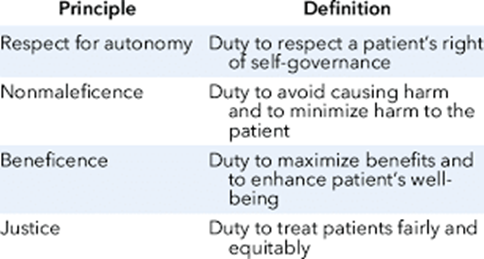A nurse manager is reviewing clients' rights with the nurses on the unit. The nurse manager should tell the nurses that informed consent promotes which of the following ethical principles?
Autonomy
Nonmaleficence
Justice
Fidelity
The Correct Answer is A
A. Autonomy is the ethical principle that respects the right of clients to make their own decisions and choices regarding their health care. Informed consent is a process that ensures that clients are fully informed of the benefits, risks, alternatives, and consequences of a proposed treatment or procedure, and that they voluntarily agree to it.
B. Nonmaleficence is the ethical principle that obliges health care providers to do no harm to clients, either intentionally or unintentionally. Informed consent does not directly promote this principle, although it may help to prevent harm by disclosing potential risks and complications.
C. Justice is the ethical principle that requires fair and equal treatment of all clients, regardless of their personal characteristics, preferences, or values. Informed consent does not directly promote this principle, although it may help to ensure that clients are not coerced or manipulated into accepting a treatment or procedure that they do not want or need.
D. Fidelity is the ethical principle that requires health care providers to be faithful and loyal to their clients, and to honor their commitments and promises. Informed consent does not directly promote this principle, although it may help to establish trust and rapport between clients and providers.

Nursing Test Bank
Naxlex Comprehensive Predictor Exams
Related Questions
Correct Answer is D
Explanation
Choice A reason:
"I should gargle with an alcohol-based mouthwash to kill germs”. This statement is not appropriate. Using an alcohol-based mouthwash is not recommended for a client with stomatitis. Alcohol can be irritating to the already inflamed mucous membranes and may worsen the condition. Instead, the client should use a mild, non-alcohol-based mouthwash or rinse as prescribed by the healthcare provider.
Choice B option
"I should limit my intake of dairy products to prevent nausea." This statement is not appropriate. While some clients may experience nausea during radiation therapy, limiting dairy products is not specifically related to stomatitis management. The client should follow any dietary recommendations provided by the healthcare provider or a registered dietitian to address nausea or other dietary concerns.
Choice C option
"I should moisten my lips with lemon-glycerine swabs." This is incorrect because lemon-glycerine swabs can be drying and irritating to the oral mucosa, which may exacerbate stomatitis symptoms. Instead, using a gentle, non-irritating lip balm or petroleum jelly is preferred.
Choice D option
"I should use a soft-bristle toothbrush to clean my teeth after meals." This response indicates an understanding of the teaching because a soft-bristle toothbrush is gentle on the gums and oral tissues, which is important for a client with stomatitis, as it helps to minimize irritation and injury.
Correct Answer is ["A","B","C","E"]
Explanation
A. Recommended: Alternating between solids and liquids can help manage nausea and vomiting. It ensures that the stomach isn't overloaded and can help in maintaining hydration and nutritional intake. Drinking liquids between meals rather than with meals can prevent over-distension of the stomach, which may reduce nausea.
B. Recommended:Eating small, frequent meals helps keep the stomach from becoming too full or too empty, which can both trigger nausea. This practice ensures a steady supply of nutrients and calories, which is especially important during pregnancy.
C. Recommended:Ginger has properties that can help soothe nausea. Warm liquids are generally more tolerated than cold liquids.
D.High-fat foods are more difficult to digest and can slow gastric emptying, which may worsen nausea and vomiting. They can also increase the risk of acid reflux, which is common during pregnancy and can exacerbate nausea.
Recommended is correct. The nurse should indicate which actions are recommended for the client.
Whether you are a student looking to ace your exams or a practicing nurse seeking to enhance your expertise , our nursing education contents will empower you with the confidence and competence to make a difference in the lives of patients and become a respected leader in the healthcare field.
Visit Naxlex, invest in your future and unlock endless possibilities with our unparalleled nursing education contents today
Report Wrong Answer on the Current Question
Do you disagree with the answer? If yes, what is your expected answer? Explain.
Kindly be descriptive with the issue you are facing.
